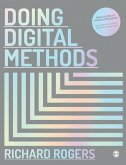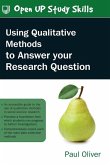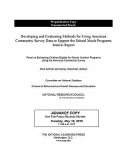- Broschiertes Buch
- Merkliste
- Auf die Merkliste
- Bewerten Bewerten
- Teilen
- Produkt teilen
- Produkterinnerung
- Produkterinnerung
The second edition of Research Methods for Education by Sandra L. Dika, Lynn Ahlgrim-Delzell, and Gregory J. Privitera employs a conversational tone to frame research as a logical, step-by-step process of making research decisions. This book will help students translate their complex educational research questions into a plan for a research project that will ultimately help them answer those questions. The text focuses on applying scientific methods in real-world educational contexts so that research feels both relevant and authentic. The authors show how methods and analysis work together to…mehr
Andere Kunden interessierten sich auch für
![Doing Digital Methods Paperback with Interactive eBook Doing Digital Methods Paperback with Interactive eBook]() Richard RogersDoing Digital Methods Paperback with Interactive eBook50,99 €
Richard RogersDoing Digital Methods Paperback with Interactive eBook50,99 €![Little Quick Fixes for Research Projects Set 2021 Little Quick Fixes for Research Projects Set 2021]() Little Quick Fixes for Research Projects Set 202174,99 €
Little Quick Fixes for Research Projects Set 202174,99 €![Conversations about Qualitative Communication Research Conversations about Qualitative Communication Research]() Christine S DavisConversations about Qualitative Communication Research45,99 €
Christine S DavisConversations about Qualitative Communication Research45,99 €![Is The Bible For Real Is The Bible For Real]() David J GonzalezIs The Bible For Real6,99 €
David J GonzalezIs The Bible For Real6,99 €![Methods and Assessment in Culture and Psychology Methods and Assessment in Culture and Psychology]() Methods and Assessment in Culture and Psychology46,99 €
Methods and Assessment in Culture and Psychology46,99 €![Using Qualitative Methods to Answer Your Research Question Using Qualitative Methods to Answer Your Research Question]() Paul OliverUsing Qualitative Methods to Answer Your Research Question32,99 €
Paul OliverUsing Qualitative Methods to Answer Your Research Question32,99 €![Developing and Evaluating Methods for Using American Community Survey Data to Support the School Meals Programs Developing and Evaluating Methods for Using American Community Survey Data to Support the School Meals Programs]() National Research CouncilDeveloping and Evaluating Methods for Using American Community Survey Data to Support the School Meals Programs44,99 €
National Research CouncilDeveloping and Evaluating Methods for Using American Community Survey Data to Support the School Meals Programs44,99 €-
-
-
The second edition of Research Methods for Education by Sandra L. Dika, Lynn Ahlgrim-Delzell, and Gregory J. Privitera employs a conversational tone to frame research as a logical, step-by-step process of making research decisions. This book will help students translate their complex educational research questions into a plan for a research project that will ultimately help them answer those questions. The text focuses on applying scientific methods in real-world educational contexts so that research feels both relevant and authentic. The authors show how methods and analysis work together to create credible, reliable, and valid quantitative, qualitative, and mixed methods educational research. Chapters logically follow the research design and analysis process as in the first edition, with a focus on ethics, measurement, literature reviews and participant selection before moving through various research designs, including nonexperimental, quasi-experimental, experimental, qualitative, and mixed methods. Each chapter is structured to show how to align research design with research questions so students understand why as well as how to apply methodology in educational contexts. Significant updates include a restructured table of contents with more emphasis on quasi-experimental research and single-case designs and more logical flow of content. New sections on validity incorporate national standards, while more clarification of qualitative and mixed methods designs helps students better understand these approaches. Throughout, new educational examples and data have been added, as well as updates for the APA 7th edition standards.
Produktdetails
- Produktdetails
- Verlag: SAGE Publications Inc
- 2 Revised edition
- Seitenzahl: 680
- Erscheinungstermin: 14. Januar 2026
- Englisch
- Abmessung: 254mm x 203mm
- Gewicht: 1220g
- ISBN-13: 9781071895009
- ISBN-10: 1071895001
- Artikelnr.: 75011846
- Herstellerkennzeichnung
- Libri GmbH
- Europaallee 1
- 36244 Bad Hersfeld
- gpsr@libri.de
- Verlag: SAGE Publications Inc
- 2 Revised edition
- Seitenzahl: 680
- Erscheinungstermin: 14. Januar 2026
- Englisch
- Abmessung: 254mm x 203mm
- Gewicht: 1220g
- ISBN-13: 9781071895009
- ISBN-10: 1071895001
- Artikelnr.: 75011846
- Herstellerkennzeichnung
- Libri GmbH
- Europaallee 1
- 36244 Bad Hersfeld
- gpsr@libri.de
Sandra L. Dika is a professor of educational research at the University of North Carolina at Charlotte, where she has taught graduate-level research methods courses since 2010 and served as Ph.D. program director from 2018 to 2025. A first-generation college graduate, she earned her B.Ed. and M.Sc. from the University of Alberta and her Ph.D. in educational research and evaluation from Virginia Tech. Prior to UNC Charlotte, she held positions at the University of Puerto Rico-Mayagüez, Virginia Tech, and Brown University. Dr. Dika's research focuses on college access, student success, and equity for historically underserved and minoritized populations. She has published more than 75 peer-reviewed articles, book chapters, and proceedings papers, and has led research funded by the Spencer Foundation, National Science Foundation, and the John M. Belk Endowment. She also serves as an external evaluator for STEM education initiatives. Her teaching and mentorship have earned her the UNC Charlotte College of Education's Excellence in Teaching and Excellence in Research Awards, and she was named a Catalyst Research Fellow in 2018. She has chaired or served on over 40 dissertation committees and has mentored more than 20 student co-authors, with two of her dissertation advisees receiving dissertation of the year awards. Dr. Dika also contributes to graduate curriculum development in research methodology. Outside of academia, she enjoys hiking, traveling, cheering on her children's sports and hobbies, and connecting with friends and family over coffee or a shared meal.
Preface
Acknowledgments
About the Authors
Chapter 1: Introduction to Scientific Thinking and the Science of Education
Introduction
The Scientific Method and Its Relevance in Educational Research
Approaches in Acquiring Knowledge
Generating and Converting Ideas to Hypotheses and Theories
Performing a Literature Review
Testing Your Idea: Confirmation and Disconfirmation
Chapter Summary
Key Terms
Review Questions
Questions and Activities for Classroom Discussion
Learning Check Answer Key
Review Question Answer Key
Chapter 2: Research Ethics
Introduction
Ethics in Educational Research
The Need for Ethics Committees in Research: A Historical Synopsis
Ethics in Focus: Classic Examples from Psychology
Human Participant Research: IRBs and the AERA Code of Ethics
Chapter Summary
Key Terms
Review Questions
Questions and Activities for Class Discussion
Learning Check Answer Key
Review Questions Answer Key
Chapter 3: Scientific Variables, Measurement, and Instrumentation
Introduction
Defining Variables, Constructs, and Operational Definitions
Types of Variables
Scales of Measurement
Classifying Data Collection Instruments
Tests and Measures
Questionnaire Items and Administration
Concepts in Validity and Reliability of Measurement
Chapter Summary
Key Terms
Review Questions
Questions and Activities for Class Discussion
Learning Check Answer Key
Review Questions Answer Key
Chapter 4: Sampling From Populations
Introduction
Why Do Researchers Select Samples?
Subjects, Participants, and Sampling Methods
Methods of Sampling: Nonprobability Sampling
Methods of Sampling: Probability Sampling
Sampling Error and Standard Error of the Mean
Potential Biases in Sampling
Chapter Summary
Key Terms
Review Questions
Questions and Activities for Class Discussion
Learning Check Answer Key
Review Questions Answer Key
Chapter 5: Choosing a Research Design
Introduction
Designing a Study to Answer a Question
Categories of Research Design
Internal and External Validity
Demonstrating Cause in an Experiment
Threats to the Internal Validity of a Research Study
Threats to the External Validity of a Research Study
External Validity, Experimentation, and Realism
Chapter Summary
Key Terms
Review Questions
Questions and Activities for Class Discussion
Learning Check Answer Key
Review Questions Answer Key
Chapter 6: Naturalistic and Existing Data Research Designs
Introduction
An Overview of Naturalistic Design
The Research Setting: Natural and Contrived Settings
Techniques for Making Unobtrusive Observations
Operationalizing Observations
Quantifying Observations
An Overview of Existing Data Designs
Chapter Summary
Key Terms
Review Questions
Questions and Activities for Class Discussion
Learning Check Answer Key
Review Questions Answer Key
Chapter 7 : Survey and Correlational Research Designs
Introduction
An Overview of Survey Designs
Surveys, Sampling, and Nonresponse Bias
Steps in Administering a Survey
The Structure of Correlational Designs
Describing the Relationship Between Variables
Limitations in Interpretation
Correlation, Regression, and Prediction
Chapter Summary
Key Terms
Review Questions
Questions and Activities for Class Discussion
Learning Check Answer Key
Review Questions Answer Key
Chapter 8: Introduction to Qualitative Research
Introduction
What Is Qualitative Research?
Distinctions Between Qualitative and Quantitative Research
Three Theoretical Perspectives in Qualitative Research
Steps in Qualitative Research
Role of the Researcher and Entry Into the Field
Sampling in Qualitative Research
Types of Qualitative Data
Chapter Summary
Key Terms
Review Questions
Questions and Activities for Classroom Discussion
Learning Check Answer Key
Review Questions Answer Key
Chapter 9: Phenomenology, Ethnography, and Grounded Theory Designs
Introduction
An Overview of Phenomenology Designs
An Overview of Ethnography Designs
An Overview of Netnography and Autoethnography Designs
An Overview of Grounded Theory Designs
Chapter Summary
Key Terms
Review Questions
Questions and Activities for Classroom Discussion
Learning Check Answer Key
Review Questions Answer Key
Chapter 10: Narrative Inquiry, Case Study, and Critical Theory Designs
Introduction
Narrative Research Designs
Case Study Designs
Critical Theory Designs
Chapter Summary
Key Terms
Review Questions
Questions and Activities for Class Discussion
Learning Check Answer Key
Review Question Answer Key
Chapter 11: Quasi-Experimental Designs
Introduction
Quasi-Experiments and Quasi-Independent Variables
One-Group Designs
Quasi-Experimental Design: Nonequivalent Control Group Designs
Quasi-Experimental Design: Time-Series Designs
Chapter Summary
Key Terms
Review Questions
Questions and Activities for Class Discussion
Learning Check Answer Key
Review Questions Answer Key
Chapter 12: Single-Case Experimental Designs
Introduction
Single-Case Designs: Reversal, Multiple-Baseline, Changing Criterion,
Alternate Treatment
Standards for Single-Case Designs
Analysis of Single-Case Designs
Chapter Summary
Key Terms
Review Questions
Questions and Activities for Class Discussion
Learning Check Answer Key
Review Questions Answer Key
Chapter 13: Group Experimental Designs: Between Subjects, Within Subjects,
and Factorial
Introduction
Conducting Experiments: Between-Subjects Design
Creating Groups and Control of the Independent Variable
Conducting Experiments: Within-Subjects Design
Conducting Experiments: Factorial Experimental Designs
Use of Test Statistics for Group Experimental Designs
Chapter Summary
Key Terms
Review Questions
Questions and Activities for Class Discussion
Learning Check Answer Key
Review Questions Answer Key
Chapter 14: Mixed Methods Research Designs
Introduction
Applying a Mixed Methods Design
Types of Mixed Methods Research Designs
Advanced Mixed Methods Designs
Chapter Summary
Key Terms
Review Questions
Questions and Activities for Class Discussion
Learning Check Answer Key
Review Questions Answer Key
Chapter 15: Action Research
Introduction
Distinguishing Traditional Research from Action Research
Types of Action Research
The Process of Conducting Action Research
Chapter Summary
Key Terms
Review Questions
Questions and Activities for Class Discussion
Learning Check Answer Key
Review Questions Answer Key
Chapter 16: Program Evaluation
Introduction
The Fundamentals of Program Evaluation
Program Evaluation Standards, Uses, and Limitations
Classifications of Program Evaluation
Models for Program Evaluation
Steps in Program Evaluation
Chapter Summary
Key Terms
Review Questions
Questions and Activities for Class Discussion
Learning Check Answer Key
Review Questions Answer Key
Chapter 17: Analysis and Interpretation: Exposition of Data
Introduction
Descriptive Statistics: Why Summarize Data?
Frequency Distributions: Tables and Graphs
Measures of Central Tendency
Measures of Variability
Graphing Means and Correlations
Using Correlation to Describe Reliability
Standard Scores, z Scores, Percentile Ranks, and Age/Grade Equivalents
Chapter Summary
Key Terms
Review Questions
Questions and Activities for Class Discussion
Learning Check Answer Key
Review Questions Answer Key
Chapter 18: Analysis and Interpretation: Making Inferences about Data
Introduction
Inferential Statistics: What Are We Making Inferences About?
Types of Error and Power
Parametric Tests: Applying the Decision Tree
Main Effects and Interactions
Nonparametric Tests: Applying the Decision Tree
Effect Size: How Big Is an Effect in the Population?
Estimation: What Are the Possible Values of a Parameter?
Chapter Summary
Key Terms
Review Questions
Questions and Activities for Class Discussion
Learning Check Answer Key
Review Questions Answer Key
Chapter 19: Analysis and Interpretation: Making Inferences About
Qualitative Data
Introduction
Qualitative Versus Quantitative Data Analysis
Decisions About How to Record Narrative Data
Decisions About Qualitative Data Analysis and Interpretation
General Process of Qualitative Data Analysis
Interpretations Made Using Different Qualitative Designs in the Data
Analysis Process
Criteria of Trustworthiness
Chapter Summary
Key Terms
Review Questions
Questions and Activities for Class Discussion
Learning Check Answer Key
Review Questions Answer Key
Chapter 20: Communicating Research: Preparing Manuscripts, Posters, and
Talks
Introduction
Elements of Communication
Writing a Manuscript: Writing Style and Language
Elements of an APA-Style Manuscript
Literature Reviews
Reporting Observations in Qualitative Research
Poster Presentations and Professional Talks
Chapter Summary
Key Terms
Review Questions
Questions and Activities for Classroom Discussion
Learning Check Answer Key
Review Questions Answer Key
Appendix A: APA-Style Writing, Sample Manuscript, and Posters
Appendix B: Instructions for Randomizing and Counterbalancing
References
Index
Acknowledgments
About the Authors
Chapter 1: Introduction to Scientific Thinking and the Science of Education
Introduction
The Scientific Method and Its Relevance in Educational Research
Approaches in Acquiring Knowledge
Generating and Converting Ideas to Hypotheses and Theories
Performing a Literature Review
Testing Your Idea: Confirmation and Disconfirmation
Chapter Summary
Key Terms
Review Questions
Questions and Activities for Classroom Discussion
Learning Check Answer Key
Review Question Answer Key
Chapter 2: Research Ethics
Introduction
Ethics in Educational Research
The Need for Ethics Committees in Research: A Historical Synopsis
Ethics in Focus: Classic Examples from Psychology
Human Participant Research: IRBs and the AERA Code of Ethics
Chapter Summary
Key Terms
Review Questions
Questions and Activities for Class Discussion
Learning Check Answer Key
Review Questions Answer Key
Chapter 3: Scientific Variables, Measurement, and Instrumentation
Introduction
Defining Variables, Constructs, and Operational Definitions
Types of Variables
Scales of Measurement
Classifying Data Collection Instruments
Tests and Measures
Questionnaire Items and Administration
Concepts in Validity and Reliability of Measurement
Chapter Summary
Key Terms
Review Questions
Questions and Activities for Class Discussion
Learning Check Answer Key
Review Questions Answer Key
Chapter 4: Sampling From Populations
Introduction
Why Do Researchers Select Samples?
Subjects, Participants, and Sampling Methods
Methods of Sampling: Nonprobability Sampling
Methods of Sampling: Probability Sampling
Sampling Error and Standard Error of the Mean
Potential Biases in Sampling
Chapter Summary
Key Terms
Review Questions
Questions and Activities for Class Discussion
Learning Check Answer Key
Review Questions Answer Key
Chapter 5: Choosing a Research Design
Introduction
Designing a Study to Answer a Question
Categories of Research Design
Internal and External Validity
Demonstrating Cause in an Experiment
Threats to the Internal Validity of a Research Study
Threats to the External Validity of a Research Study
External Validity, Experimentation, and Realism
Chapter Summary
Key Terms
Review Questions
Questions and Activities for Class Discussion
Learning Check Answer Key
Review Questions Answer Key
Chapter 6: Naturalistic and Existing Data Research Designs
Introduction
An Overview of Naturalistic Design
The Research Setting: Natural and Contrived Settings
Techniques for Making Unobtrusive Observations
Operationalizing Observations
Quantifying Observations
An Overview of Existing Data Designs
Chapter Summary
Key Terms
Review Questions
Questions and Activities for Class Discussion
Learning Check Answer Key
Review Questions Answer Key
Chapter 7 : Survey and Correlational Research Designs
Introduction
An Overview of Survey Designs
Surveys, Sampling, and Nonresponse Bias
Steps in Administering a Survey
The Structure of Correlational Designs
Describing the Relationship Between Variables
Limitations in Interpretation
Correlation, Regression, and Prediction
Chapter Summary
Key Terms
Review Questions
Questions and Activities for Class Discussion
Learning Check Answer Key
Review Questions Answer Key
Chapter 8: Introduction to Qualitative Research
Introduction
What Is Qualitative Research?
Distinctions Between Qualitative and Quantitative Research
Three Theoretical Perspectives in Qualitative Research
Steps in Qualitative Research
Role of the Researcher and Entry Into the Field
Sampling in Qualitative Research
Types of Qualitative Data
Chapter Summary
Key Terms
Review Questions
Questions and Activities for Classroom Discussion
Learning Check Answer Key
Review Questions Answer Key
Chapter 9: Phenomenology, Ethnography, and Grounded Theory Designs
Introduction
An Overview of Phenomenology Designs
An Overview of Ethnography Designs
An Overview of Netnography and Autoethnography Designs
An Overview of Grounded Theory Designs
Chapter Summary
Key Terms
Review Questions
Questions and Activities for Classroom Discussion
Learning Check Answer Key
Review Questions Answer Key
Chapter 10: Narrative Inquiry, Case Study, and Critical Theory Designs
Introduction
Narrative Research Designs
Case Study Designs
Critical Theory Designs
Chapter Summary
Key Terms
Review Questions
Questions and Activities for Class Discussion
Learning Check Answer Key
Review Question Answer Key
Chapter 11: Quasi-Experimental Designs
Introduction
Quasi-Experiments and Quasi-Independent Variables
One-Group Designs
Quasi-Experimental Design: Nonequivalent Control Group Designs
Quasi-Experimental Design: Time-Series Designs
Chapter Summary
Key Terms
Review Questions
Questions and Activities for Class Discussion
Learning Check Answer Key
Review Questions Answer Key
Chapter 12: Single-Case Experimental Designs
Introduction
Single-Case Designs: Reversal, Multiple-Baseline, Changing Criterion,
Alternate Treatment
Standards for Single-Case Designs
Analysis of Single-Case Designs
Chapter Summary
Key Terms
Review Questions
Questions and Activities for Class Discussion
Learning Check Answer Key
Review Questions Answer Key
Chapter 13: Group Experimental Designs: Between Subjects, Within Subjects,
and Factorial
Introduction
Conducting Experiments: Between-Subjects Design
Creating Groups and Control of the Independent Variable
Conducting Experiments: Within-Subjects Design
Conducting Experiments: Factorial Experimental Designs
Use of Test Statistics for Group Experimental Designs
Chapter Summary
Key Terms
Review Questions
Questions and Activities for Class Discussion
Learning Check Answer Key
Review Questions Answer Key
Chapter 14: Mixed Methods Research Designs
Introduction
Applying a Mixed Methods Design
Types of Mixed Methods Research Designs
Advanced Mixed Methods Designs
Chapter Summary
Key Terms
Review Questions
Questions and Activities for Class Discussion
Learning Check Answer Key
Review Questions Answer Key
Chapter 15: Action Research
Introduction
Distinguishing Traditional Research from Action Research
Types of Action Research
The Process of Conducting Action Research
Chapter Summary
Key Terms
Review Questions
Questions and Activities for Class Discussion
Learning Check Answer Key
Review Questions Answer Key
Chapter 16: Program Evaluation
Introduction
The Fundamentals of Program Evaluation
Program Evaluation Standards, Uses, and Limitations
Classifications of Program Evaluation
Models for Program Evaluation
Steps in Program Evaluation
Chapter Summary
Key Terms
Review Questions
Questions and Activities for Class Discussion
Learning Check Answer Key
Review Questions Answer Key
Chapter 17: Analysis and Interpretation: Exposition of Data
Introduction
Descriptive Statistics: Why Summarize Data?
Frequency Distributions: Tables and Graphs
Measures of Central Tendency
Measures of Variability
Graphing Means and Correlations
Using Correlation to Describe Reliability
Standard Scores, z Scores, Percentile Ranks, and Age/Grade Equivalents
Chapter Summary
Key Terms
Review Questions
Questions and Activities for Class Discussion
Learning Check Answer Key
Review Questions Answer Key
Chapter 18: Analysis and Interpretation: Making Inferences about Data
Introduction
Inferential Statistics: What Are We Making Inferences About?
Types of Error and Power
Parametric Tests: Applying the Decision Tree
Main Effects and Interactions
Nonparametric Tests: Applying the Decision Tree
Effect Size: How Big Is an Effect in the Population?
Estimation: What Are the Possible Values of a Parameter?
Chapter Summary
Key Terms
Review Questions
Questions and Activities for Class Discussion
Learning Check Answer Key
Review Questions Answer Key
Chapter 19: Analysis and Interpretation: Making Inferences About
Qualitative Data
Introduction
Qualitative Versus Quantitative Data Analysis
Decisions About How to Record Narrative Data
Decisions About Qualitative Data Analysis and Interpretation
General Process of Qualitative Data Analysis
Interpretations Made Using Different Qualitative Designs in the Data
Analysis Process
Criteria of Trustworthiness
Chapter Summary
Key Terms
Review Questions
Questions and Activities for Class Discussion
Learning Check Answer Key
Review Questions Answer Key
Chapter 20: Communicating Research: Preparing Manuscripts, Posters, and
Talks
Introduction
Elements of Communication
Writing a Manuscript: Writing Style and Language
Elements of an APA-Style Manuscript
Literature Reviews
Reporting Observations in Qualitative Research
Poster Presentations and Professional Talks
Chapter Summary
Key Terms
Review Questions
Questions and Activities for Classroom Discussion
Learning Check Answer Key
Review Questions Answer Key
Appendix A: APA-Style Writing, Sample Manuscript, and Posters
Appendix B: Instructions for Randomizing and Counterbalancing
References
Index
Preface
Acknowledgments
About the Authors
Chapter 1: Introduction to Scientific Thinking and the Science of Education
Introduction
The Scientific Method and Its Relevance in Educational Research
Approaches in Acquiring Knowledge
Generating and Converting Ideas to Hypotheses and Theories
Performing a Literature Review
Testing Your Idea: Confirmation and Disconfirmation
Chapter Summary
Key Terms
Review Questions
Questions and Activities for Classroom Discussion
Learning Check Answer Key
Review Question Answer Key
Chapter 2: Research Ethics
Introduction
Ethics in Educational Research
The Need for Ethics Committees in Research: A Historical Synopsis
Ethics in Focus: Classic Examples from Psychology
Human Participant Research: IRBs and the AERA Code of Ethics
Chapter Summary
Key Terms
Review Questions
Questions and Activities for Class Discussion
Learning Check Answer Key
Review Questions Answer Key
Chapter 3: Scientific Variables, Measurement, and Instrumentation
Introduction
Defining Variables, Constructs, and Operational Definitions
Types of Variables
Scales of Measurement
Classifying Data Collection Instruments
Tests and Measures
Questionnaire Items and Administration
Concepts in Validity and Reliability of Measurement
Chapter Summary
Key Terms
Review Questions
Questions and Activities for Class Discussion
Learning Check Answer Key
Review Questions Answer Key
Chapter 4: Sampling From Populations
Introduction
Why Do Researchers Select Samples?
Subjects, Participants, and Sampling Methods
Methods of Sampling: Nonprobability Sampling
Methods of Sampling: Probability Sampling
Sampling Error and Standard Error of the Mean
Potential Biases in Sampling
Chapter Summary
Key Terms
Review Questions
Questions and Activities for Class Discussion
Learning Check Answer Key
Review Questions Answer Key
Chapter 5: Choosing a Research Design
Introduction
Designing a Study to Answer a Question
Categories of Research Design
Internal and External Validity
Demonstrating Cause in an Experiment
Threats to the Internal Validity of a Research Study
Threats to the External Validity of a Research Study
External Validity, Experimentation, and Realism
Chapter Summary
Key Terms
Review Questions
Questions and Activities for Class Discussion
Learning Check Answer Key
Review Questions Answer Key
Chapter 6: Naturalistic and Existing Data Research Designs
Introduction
An Overview of Naturalistic Design
The Research Setting: Natural and Contrived Settings
Techniques for Making Unobtrusive Observations
Operationalizing Observations
Quantifying Observations
An Overview of Existing Data Designs
Chapter Summary
Key Terms
Review Questions
Questions and Activities for Class Discussion
Learning Check Answer Key
Review Questions Answer Key
Chapter 7 : Survey and Correlational Research Designs
Introduction
An Overview of Survey Designs
Surveys, Sampling, and Nonresponse Bias
Steps in Administering a Survey
The Structure of Correlational Designs
Describing the Relationship Between Variables
Limitations in Interpretation
Correlation, Regression, and Prediction
Chapter Summary
Key Terms
Review Questions
Questions and Activities for Class Discussion
Learning Check Answer Key
Review Questions Answer Key
Chapter 8: Introduction to Qualitative Research
Introduction
What Is Qualitative Research?
Distinctions Between Qualitative and Quantitative Research
Three Theoretical Perspectives in Qualitative Research
Steps in Qualitative Research
Role of the Researcher and Entry Into the Field
Sampling in Qualitative Research
Types of Qualitative Data
Chapter Summary
Key Terms
Review Questions
Questions and Activities for Classroom Discussion
Learning Check Answer Key
Review Questions Answer Key
Chapter 9: Phenomenology, Ethnography, and Grounded Theory Designs
Introduction
An Overview of Phenomenology Designs
An Overview of Ethnography Designs
An Overview of Netnography and Autoethnography Designs
An Overview of Grounded Theory Designs
Chapter Summary
Key Terms
Review Questions
Questions and Activities for Classroom Discussion
Learning Check Answer Key
Review Questions Answer Key
Chapter 10: Narrative Inquiry, Case Study, and Critical Theory Designs
Introduction
Narrative Research Designs
Case Study Designs
Critical Theory Designs
Chapter Summary
Key Terms
Review Questions
Questions and Activities for Class Discussion
Learning Check Answer Key
Review Question Answer Key
Chapter 11: Quasi-Experimental Designs
Introduction
Quasi-Experiments and Quasi-Independent Variables
One-Group Designs
Quasi-Experimental Design: Nonequivalent Control Group Designs
Quasi-Experimental Design: Time-Series Designs
Chapter Summary
Key Terms
Review Questions
Questions and Activities for Class Discussion
Learning Check Answer Key
Review Questions Answer Key
Chapter 12: Single-Case Experimental Designs
Introduction
Single-Case Designs: Reversal, Multiple-Baseline, Changing Criterion,
Alternate Treatment
Standards for Single-Case Designs
Analysis of Single-Case Designs
Chapter Summary
Key Terms
Review Questions
Questions and Activities for Class Discussion
Learning Check Answer Key
Review Questions Answer Key
Chapter 13: Group Experimental Designs: Between Subjects, Within Subjects,
and Factorial
Introduction
Conducting Experiments: Between-Subjects Design
Creating Groups and Control of the Independent Variable
Conducting Experiments: Within-Subjects Design
Conducting Experiments: Factorial Experimental Designs
Use of Test Statistics for Group Experimental Designs
Chapter Summary
Key Terms
Review Questions
Questions and Activities for Class Discussion
Learning Check Answer Key
Review Questions Answer Key
Chapter 14: Mixed Methods Research Designs
Introduction
Applying a Mixed Methods Design
Types of Mixed Methods Research Designs
Advanced Mixed Methods Designs
Chapter Summary
Key Terms
Review Questions
Questions and Activities for Class Discussion
Learning Check Answer Key
Review Questions Answer Key
Chapter 15: Action Research
Introduction
Distinguishing Traditional Research from Action Research
Types of Action Research
The Process of Conducting Action Research
Chapter Summary
Key Terms
Review Questions
Questions and Activities for Class Discussion
Learning Check Answer Key
Review Questions Answer Key
Chapter 16: Program Evaluation
Introduction
The Fundamentals of Program Evaluation
Program Evaluation Standards, Uses, and Limitations
Classifications of Program Evaluation
Models for Program Evaluation
Steps in Program Evaluation
Chapter Summary
Key Terms
Review Questions
Questions and Activities for Class Discussion
Learning Check Answer Key
Review Questions Answer Key
Chapter 17: Analysis and Interpretation: Exposition of Data
Introduction
Descriptive Statistics: Why Summarize Data?
Frequency Distributions: Tables and Graphs
Measures of Central Tendency
Measures of Variability
Graphing Means and Correlations
Using Correlation to Describe Reliability
Standard Scores, z Scores, Percentile Ranks, and Age/Grade Equivalents
Chapter Summary
Key Terms
Review Questions
Questions and Activities for Class Discussion
Learning Check Answer Key
Review Questions Answer Key
Chapter 18: Analysis and Interpretation: Making Inferences about Data
Introduction
Inferential Statistics: What Are We Making Inferences About?
Types of Error and Power
Parametric Tests: Applying the Decision Tree
Main Effects and Interactions
Nonparametric Tests: Applying the Decision Tree
Effect Size: How Big Is an Effect in the Population?
Estimation: What Are the Possible Values of a Parameter?
Chapter Summary
Key Terms
Review Questions
Questions and Activities for Class Discussion
Learning Check Answer Key
Review Questions Answer Key
Chapter 19: Analysis and Interpretation: Making Inferences About
Qualitative Data
Introduction
Qualitative Versus Quantitative Data Analysis
Decisions About How to Record Narrative Data
Decisions About Qualitative Data Analysis and Interpretation
General Process of Qualitative Data Analysis
Interpretations Made Using Different Qualitative Designs in the Data
Analysis Process
Criteria of Trustworthiness
Chapter Summary
Key Terms
Review Questions
Questions and Activities for Class Discussion
Learning Check Answer Key
Review Questions Answer Key
Chapter 20: Communicating Research: Preparing Manuscripts, Posters, and
Talks
Introduction
Elements of Communication
Writing a Manuscript: Writing Style and Language
Elements of an APA-Style Manuscript
Literature Reviews
Reporting Observations in Qualitative Research
Poster Presentations and Professional Talks
Chapter Summary
Key Terms
Review Questions
Questions and Activities for Classroom Discussion
Learning Check Answer Key
Review Questions Answer Key
Appendix A: APA-Style Writing, Sample Manuscript, and Posters
Appendix B: Instructions for Randomizing and Counterbalancing
References
Index
Acknowledgments
About the Authors
Chapter 1: Introduction to Scientific Thinking and the Science of Education
Introduction
The Scientific Method and Its Relevance in Educational Research
Approaches in Acquiring Knowledge
Generating and Converting Ideas to Hypotheses and Theories
Performing a Literature Review
Testing Your Idea: Confirmation and Disconfirmation
Chapter Summary
Key Terms
Review Questions
Questions and Activities for Classroom Discussion
Learning Check Answer Key
Review Question Answer Key
Chapter 2: Research Ethics
Introduction
Ethics in Educational Research
The Need for Ethics Committees in Research: A Historical Synopsis
Ethics in Focus: Classic Examples from Psychology
Human Participant Research: IRBs and the AERA Code of Ethics
Chapter Summary
Key Terms
Review Questions
Questions and Activities for Class Discussion
Learning Check Answer Key
Review Questions Answer Key
Chapter 3: Scientific Variables, Measurement, and Instrumentation
Introduction
Defining Variables, Constructs, and Operational Definitions
Types of Variables
Scales of Measurement
Classifying Data Collection Instruments
Tests and Measures
Questionnaire Items and Administration
Concepts in Validity and Reliability of Measurement
Chapter Summary
Key Terms
Review Questions
Questions and Activities for Class Discussion
Learning Check Answer Key
Review Questions Answer Key
Chapter 4: Sampling From Populations
Introduction
Why Do Researchers Select Samples?
Subjects, Participants, and Sampling Methods
Methods of Sampling: Nonprobability Sampling
Methods of Sampling: Probability Sampling
Sampling Error and Standard Error of the Mean
Potential Biases in Sampling
Chapter Summary
Key Terms
Review Questions
Questions and Activities for Class Discussion
Learning Check Answer Key
Review Questions Answer Key
Chapter 5: Choosing a Research Design
Introduction
Designing a Study to Answer a Question
Categories of Research Design
Internal and External Validity
Demonstrating Cause in an Experiment
Threats to the Internal Validity of a Research Study
Threats to the External Validity of a Research Study
External Validity, Experimentation, and Realism
Chapter Summary
Key Terms
Review Questions
Questions and Activities for Class Discussion
Learning Check Answer Key
Review Questions Answer Key
Chapter 6: Naturalistic and Existing Data Research Designs
Introduction
An Overview of Naturalistic Design
The Research Setting: Natural and Contrived Settings
Techniques for Making Unobtrusive Observations
Operationalizing Observations
Quantifying Observations
An Overview of Existing Data Designs
Chapter Summary
Key Terms
Review Questions
Questions and Activities for Class Discussion
Learning Check Answer Key
Review Questions Answer Key
Chapter 7 : Survey and Correlational Research Designs
Introduction
An Overview of Survey Designs
Surveys, Sampling, and Nonresponse Bias
Steps in Administering a Survey
The Structure of Correlational Designs
Describing the Relationship Between Variables
Limitations in Interpretation
Correlation, Regression, and Prediction
Chapter Summary
Key Terms
Review Questions
Questions and Activities for Class Discussion
Learning Check Answer Key
Review Questions Answer Key
Chapter 8: Introduction to Qualitative Research
Introduction
What Is Qualitative Research?
Distinctions Between Qualitative and Quantitative Research
Three Theoretical Perspectives in Qualitative Research
Steps in Qualitative Research
Role of the Researcher and Entry Into the Field
Sampling in Qualitative Research
Types of Qualitative Data
Chapter Summary
Key Terms
Review Questions
Questions and Activities for Classroom Discussion
Learning Check Answer Key
Review Questions Answer Key
Chapter 9: Phenomenology, Ethnography, and Grounded Theory Designs
Introduction
An Overview of Phenomenology Designs
An Overview of Ethnography Designs
An Overview of Netnography and Autoethnography Designs
An Overview of Grounded Theory Designs
Chapter Summary
Key Terms
Review Questions
Questions and Activities for Classroom Discussion
Learning Check Answer Key
Review Questions Answer Key
Chapter 10: Narrative Inquiry, Case Study, and Critical Theory Designs
Introduction
Narrative Research Designs
Case Study Designs
Critical Theory Designs
Chapter Summary
Key Terms
Review Questions
Questions and Activities for Class Discussion
Learning Check Answer Key
Review Question Answer Key
Chapter 11: Quasi-Experimental Designs
Introduction
Quasi-Experiments and Quasi-Independent Variables
One-Group Designs
Quasi-Experimental Design: Nonequivalent Control Group Designs
Quasi-Experimental Design: Time-Series Designs
Chapter Summary
Key Terms
Review Questions
Questions and Activities for Class Discussion
Learning Check Answer Key
Review Questions Answer Key
Chapter 12: Single-Case Experimental Designs
Introduction
Single-Case Designs: Reversal, Multiple-Baseline, Changing Criterion,
Alternate Treatment
Standards for Single-Case Designs
Analysis of Single-Case Designs
Chapter Summary
Key Terms
Review Questions
Questions and Activities for Class Discussion
Learning Check Answer Key
Review Questions Answer Key
Chapter 13: Group Experimental Designs: Between Subjects, Within Subjects,
and Factorial
Introduction
Conducting Experiments: Between-Subjects Design
Creating Groups and Control of the Independent Variable
Conducting Experiments: Within-Subjects Design
Conducting Experiments: Factorial Experimental Designs
Use of Test Statistics for Group Experimental Designs
Chapter Summary
Key Terms
Review Questions
Questions and Activities for Class Discussion
Learning Check Answer Key
Review Questions Answer Key
Chapter 14: Mixed Methods Research Designs
Introduction
Applying a Mixed Methods Design
Types of Mixed Methods Research Designs
Advanced Mixed Methods Designs
Chapter Summary
Key Terms
Review Questions
Questions and Activities for Class Discussion
Learning Check Answer Key
Review Questions Answer Key
Chapter 15: Action Research
Introduction
Distinguishing Traditional Research from Action Research
Types of Action Research
The Process of Conducting Action Research
Chapter Summary
Key Terms
Review Questions
Questions and Activities for Class Discussion
Learning Check Answer Key
Review Questions Answer Key
Chapter 16: Program Evaluation
Introduction
The Fundamentals of Program Evaluation
Program Evaluation Standards, Uses, and Limitations
Classifications of Program Evaluation
Models for Program Evaluation
Steps in Program Evaluation
Chapter Summary
Key Terms
Review Questions
Questions and Activities for Class Discussion
Learning Check Answer Key
Review Questions Answer Key
Chapter 17: Analysis and Interpretation: Exposition of Data
Introduction
Descriptive Statistics: Why Summarize Data?
Frequency Distributions: Tables and Graphs
Measures of Central Tendency
Measures of Variability
Graphing Means and Correlations
Using Correlation to Describe Reliability
Standard Scores, z Scores, Percentile Ranks, and Age/Grade Equivalents
Chapter Summary
Key Terms
Review Questions
Questions and Activities for Class Discussion
Learning Check Answer Key
Review Questions Answer Key
Chapter 18: Analysis and Interpretation: Making Inferences about Data
Introduction
Inferential Statistics: What Are We Making Inferences About?
Types of Error and Power
Parametric Tests: Applying the Decision Tree
Main Effects and Interactions
Nonparametric Tests: Applying the Decision Tree
Effect Size: How Big Is an Effect in the Population?
Estimation: What Are the Possible Values of a Parameter?
Chapter Summary
Key Terms
Review Questions
Questions and Activities for Class Discussion
Learning Check Answer Key
Review Questions Answer Key
Chapter 19: Analysis and Interpretation: Making Inferences About
Qualitative Data
Introduction
Qualitative Versus Quantitative Data Analysis
Decisions About How to Record Narrative Data
Decisions About Qualitative Data Analysis and Interpretation
General Process of Qualitative Data Analysis
Interpretations Made Using Different Qualitative Designs in the Data
Analysis Process
Criteria of Trustworthiness
Chapter Summary
Key Terms
Review Questions
Questions and Activities for Class Discussion
Learning Check Answer Key
Review Questions Answer Key
Chapter 20: Communicating Research: Preparing Manuscripts, Posters, and
Talks
Introduction
Elements of Communication
Writing a Manuscript: Writing Style and Language
Elements of an APA-Style Manuscript
Literature Reviews
Reporting Observations in Qualitative Research
Poster Presentations and Professional Talks
Chapter Summary
Key Terms
Review Questions
Questions and Activities for Classroom Discussion
Learning Check Answer Key
Review Questions Answer Key
Appendix A: APA-Style Writing, Sample Manuscript, and Posters
Appendix B: Instructions for Randomizing and Counterbalancing
References
Index








